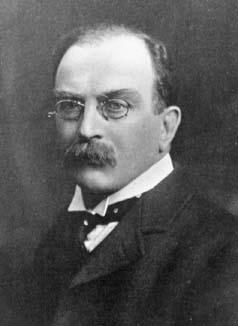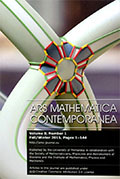Algorithms is a monthly peer-reviewed open-access scientific journal of mathematics, covering design, analysis, and experiments on algorithms. The journal is published by MDPI and was established in 2008. The founding editor-in-chief was Kazuo Iwama. From May 2014 to September 2019, the editor-in-chief was Henning Fernau. The current editor-in-chief is Frank Werner.

The Edinburgh Mathematical Society is a mathematical society for academics in Scotland.

Sir Joseph Larmor was an Irish physicist and mathematician who made breakthroughs in the understanding of electricity, dynamics, thermodynamics, and the electron theory of matter. His most influential work was Aether and Matter, a theoretical physics book published in 1900.
zbMATHOpen, formerly Zentralblatt MATH, is a major reviewing service providing reviews and abstracts for articles in pure and applied mathematics, produced by the Berlin office of FIZ Karlsruhe – Leibniz Institute for Information Infrastructure GmbH. Editors are the European Mathematical Society, FIZ Karlsruhe, and the Heidelberg Academy of Sciences. zbMATH is distributed by Springer Science+Business Media. It uses the Mathematics Subject Classification codes for organising reviews by topic.

The Cambridge Philosophical Society (CPS) is a scientific society at the University of Cambridge. It was founded in 1819. The name derives from the medieval use of the word philosophy to denote any research undertaken outside the fields of law, theology and medicine. The society was granted a royal charter by King William IV in 1832. The society is governed by an elected council of senior academics, which is chaired by the Society's President, according to a set of statutes.

The European Journal of Combinatorics is an international peer-reviewed scientific journal that specializes in combinatorics. The journal primarily publishes papers dealing with mathematical structures within combinatorics and/or establishing direct links between combinatorics and the theories of computing. The journal includes full-length research papers, short notes, and research problems on several topics.

Synthese is a monthly peer-reviewed academic journal covering the epistemology, methodology, and philosophy of science, and related issues. The name Synthese finds its origin in the intentions of its founding editors: making explicit the supposed internal coherence between the different, highly specialised scientific disciplines. Jaakko Hintikka was editor-in-chief from 1965 to 2002. The current editors-in-chief are Otávio Bueno, Wiebe van der Hoek, and Kristie Miller.

Ars Mathematica Contemporanea is a quarterly peer-reviewed scientific journal covering discrete mathematics in connection with other branches of mathematics. It is published by the University of Primorska together with the Society of Mathematicians, Physicists and Astronomers of Slovenia, the Institute of Mathematics, Physics, and Mechanics, and the Slovenian Discrete and Applied Mathematics Society. It is a platinum open access journal, with articles published under the Creative Commons Attribution 4.0 license.
Opuscula Mathematica is a mathematical research journal founded in 1937 in Kraków, Poland, by Professor Antoni Hoborski, an outstanding mathematician, the first Rector Magnificus of the Mining Academy, a co-establisher of the Polish Mathematical Society.

The Mathematical Gazette is a triannual peer-reviewed academic journal published by Cambridge University Press on behalf of the Mathematical Association. It covers mathematics education with a focus on the 15–20 years age range.

Complexity is a peer-reviewed open-access scientific journal covering the field of complex adaptive systems. The journal's scope includes Chaos theory, genetic algorithms, cellular automata, neural networks, evolutionary game theory, and econophysics. It was established in 1995 and is published by John Wiley & Sons.
The International Journal of Applied Mathematics and Computer Science is a quarterly peer-reviewed scientific journal published since 1991 by the University of Zielona Góra in partnership with De Gruyter Poland and Lubuskie Scientific Society, under the auspices of the Committee on Automatic Control and Robotics of the Polish Academy of Sciences. The editor-in-chief is Józef Korbicz. The journal covers various fields related to control theory, applied mathematics, scientific computing, and computer science.

Forum of Mathematics, Pi and Forum of Mathematics, Sigma are open-access peer-reviewed journals for mathematics published under a creative commons license by Cambridge University Press. The founding managing editor was Rob Kirby. He was succeeded by Robert Guralnick, who is currently the managing editor of both journals.

The Bulletin of Mathematical Sciences is a triannual peer-reviewed scientific journal of mathematics published by World Scientific as a diamond open access journal with article processing charges covered by King Abdulaziz University. The journal publishes expository papers, mostly invited, in all areas of mathematics, as well as short papers with original research. The journal's editors-in-chief are Efim Zelmanov, S.K. Jain, and Ahmed Alsaedi. The journal was established in 2011.
Mathematics is a semi-monthly peer-reviewed open-access scientific journal that covers all aspects of pure mathematics and applied mathematics. It publishes theoretical and experimental research articles, short communications, and reviews. It was established in 2013 and is published by MDPI. The editor-in-chief is Francisco Chiclana.

Quanta is an open access scientific journal covering the foundations of quantum mechanics, mathematical physics, and philosophy of science. The first volume, dedicated to the work of Karl Popper on foundations of quantum mechanics, was published on November 15, 2012. The editor-in-chief and publisher is Danko Georgiev.
Symmetry is a monthly peer-reviewed open access scientific journal published by MDPI covering several aspects of theories and applications related to symmetry/asymmetry phenomena in the natural sciences. The journal was established in 2009 and the editor-in-chief is Sergei Odintsov. The journal features occasional special issues on specific selected topics.
The Journal d'Analyse Mathématique is a triannual peer-reviewed scientific journal published by Springer Science+Business Media on behalf of Magnes Press. It was established in 1951 by Binyamin Amirà.
The Nieuw Archief voor Wiskunde is a quarterly Dutch peer-reviewed scientific journal of mathematics published by the Koninklijk Wiskundig Genootschap since 1875. The new version, the fifth series, started in 2000. The journal covers developments in mathematics in general and in Dutch mathematics in particular. It is abstracted and indexed in zbMATH Open.
Statistica Neerlandica is a quarterly peer-reviewed scientific journal published by Wiley on behalf of the Netherlands Society for Statistics and Operations Research. The journal was established in 1946 and covers all areas of statistics. The editors-in-chief are Edwin van den Heuvel, Veronica Vinciotti, and Ernst-Jan Camiel Wit.










